Lameness can occur in any horse at any time, even if you have done everything in your power to prevent it. If you have not experienced lameness in one of your own horses yet, chances are you will eventually.
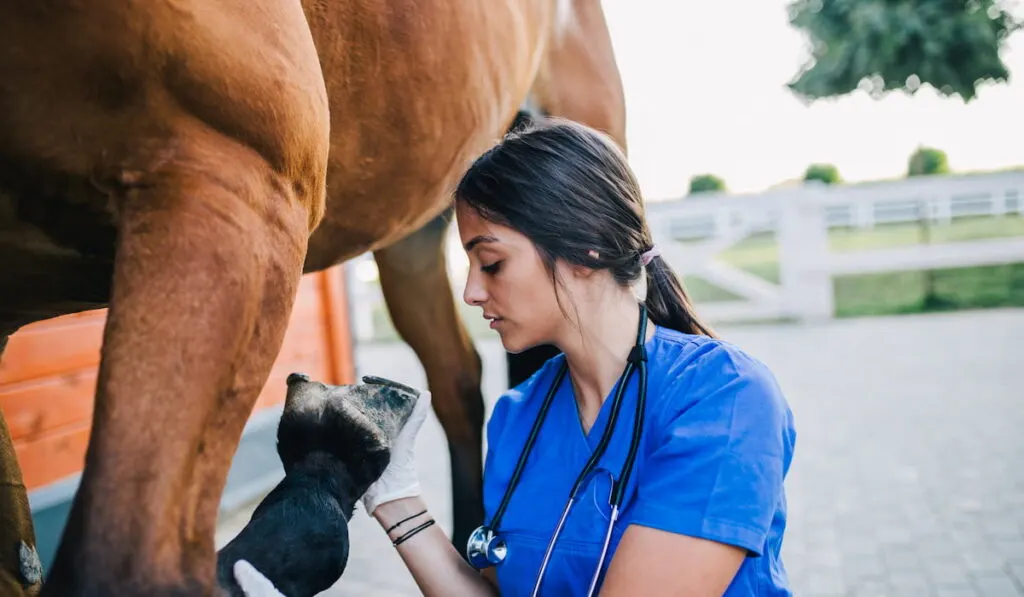
In 2015, the National Animal Health Monitoring System (NAHMS) conducted a survey and found that 67.1% of farms had horses that experienced lameness within the last 12 months.
Horse lameness is an abnormal change in the gait of a horse that results in a decreased ability or desire to perform at its normal capacity. Lameness is not a disease, but it is a symptom of other diseases, illnesses, or injuries. The cause of the lameness needs to be diagnosed and treated.
Most experienced equestrians can spot the signs of lameness in their horses early, which is critical to the horse’s long-term outlook. Most often, lameness is the horse’s response to the pain that an injury or disease is causing. The more you know about lameness, how to spot it and how to treat it, the better you will be able to care for your horses for the long haul.
Table of Contents
Signs of Horse Lameness
Recognizing the signs of lameness in a horse is probably easier than you think. Some signs are more severe which makes them easier to spot. Other times you may just notice that something seems ‘off’ in the way your horse is walking or behaving. The following are the most common signs of lameness in horses. (source)
Abnormal Gait
Most often, horse owners will first notice that their horse is walking strangely or differently than normal. The horse may be favoring a particular leg, meaning it avoids putting too much weight on it or using it at all. You may even notice that the change is more pronounced when the horse moves from a fast walk to a trot. It may even refuse to change gait at all. (source)
Unwillingness to Move
A horse with lameness may show an unwillingness to move at all, or it may refuse to put a lot of weight on a certain leg which limits its ability to move.
Even when you give the horse feed or do something that would normally cause excitement or movement, the horse will show little interest and continue to stay in the same place.
A lame horse may also refuse to move onto different surface types depending on the source of their pain. A painful hoof could cause a horse to refuse to walk on hard or rocky terrain. (source)
Head Bobbing
If the lameness is severe, you may even notice a horse’s head bobbing or nodding noticeably as it trots or walks, especially as it tries to shift the weight off of its injured leg.
Interestingly, the way that a horse bobs its head will help you determine which leg is causing the problem.
If a horse’s head drops noticeably as it walks or trots, then the issue more than likely is in the back legs. If a horse bobs its head upwards more than downwards, then the problem is probably in the front legs. (source)
Problems Turning in a Circle
Sometimes the signs of lameness are more pronounced when a horse turns in a circle. You may not even notice an issue until you ask them to turn. Turning puts different pressure on the joint and can exacerbate pain in an injured area. (source)
Standing Awkwardly
You may notice that your horse is not standing normally. They may be standing to one side in an effort to take the weight off of an affected leg. Their hips and/or shoulders may appear lopsided or uneven.
To be sure, stand behind them – a safe distance from potential kicks – and check the symmetry of their hindquarters. Look to see if you notice any significant changes or differences from one side to another.
Confirming a Suspicion of Lameness
Unfortunately, the signs of lameness in some situations may be subtle. You can tell that something is different in your horse’s gait, but you may be unable to pinpoint the exact root of the problem.
If you have any suspicions that your horse may be showing the signs of lameness, you should have a veterinarian examine your horse as soon as possible.
Lameness is most often the result of pain of some kind, so a lame horse can be experiencing discomfort that could be connected to a serious injury or illness. Once a vet confirms which leg is being affected, he or she can then work to trace the source of the issue.
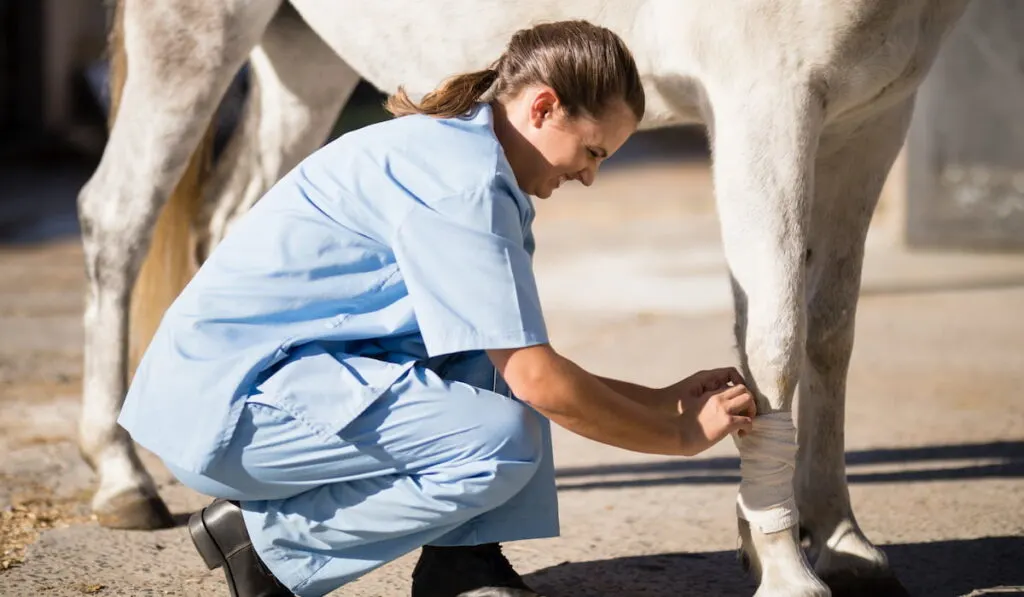
Confirm your Suspicions and Prepare for the Vet
While you wait for a vet, or if you are trying to decide if they lameness is real or imagined, here are a few tips to help you detect lameness in your horse and prepare for your vet visit. (source)
- Try having someone else walk your horse on a soft surface like grass while you watch out for any problems or awkward transitions. Sometimes the issue will be more pronounced when they speed up or try to slow down.
- Pay close attention to any leg they appear to be favoring, which means they step on it gently and avoid putting weight on it.
- Have someone walk the horse in circles. Often, the signs of lameness will be more noticeable as the horse turns.
- If your horse is reluctant to move at all, wait until your vet can examine it. Asking a severely lame horse to walk or trot could make the issue worse.
- Write down all the information you can remember about any possible injuries or events that could have caused or contributed to the problem. Also, jot down any information you can remember about any previous bouts of lameness with this particular horse. Your vet will need and appreciate this information.
Possible Causes of Lameness
Any official diagnosis for the cause of severe lameness should be determined by a veterinarian. While some lameness issues can be resolved easily by an experienced equestrian, most of us need the help of a professional, especially when it comes to lameness.
Without some kind of intervention, there is a good change the lameness will not go away and may even worsen over time. The quicker that you consult a veterinarian, the quicker your horse’s issues can be resolved. Some of the most common diagnoses are listed here.
Back Injury
A spinal injury or problem in a horse can cause lameness in one or more of its limbs. Unfortunately, a horse has a relatively rigid spine that lacks flexibility. Flipping over, falling or participating in jumping activities can result in strain and spinal injury.
Some conditions that often affect jumping horses are an acute sacroiliac strain, or ‘kissing spine,’ which is an overlapping of a horse’s vertebrae. Both of these can cause severe pain that results in lameness.
Horses experiencing lameness due to back injuries will often collapse if you try to ride them, or may be unable to urinate properly or move at their normal speeds. (source)
Muscle Sprain or Strain
A muscle sprain happens abruptly when a joint is twisted or turned in a way that tears or severely stretches a ligament or muscle. A strain is different from a sprain because it is a stretching that occurs when a horse overuses it or moves in an unnatural way.
Horses don’t have any muscles in their legs below the knee or hock, so muscle injuries usually occur higher up the leg or in the hip or shoulder.
A sprain is often more painful and takes longer to heal than a strain. These injuries most often occur during sporting activities or due to horses playing too hard. (source)
Bone Fracture
A fracture can range from less severe hairline fractures to severe breaks that may or may not come through the horse’s skin. Most often, fractures are the result of bad falls, tripping, stepping into a deep hole or fighting with another horse.
While some fractures are so severe that the injuries can potentially be fatal, advances in technology and veterinary medicine have allowed many leg fractures to be treated without successfully. Leg fractures usually result in noticeable and immediate lameness in the affected leg. (source)
Tendon Injury
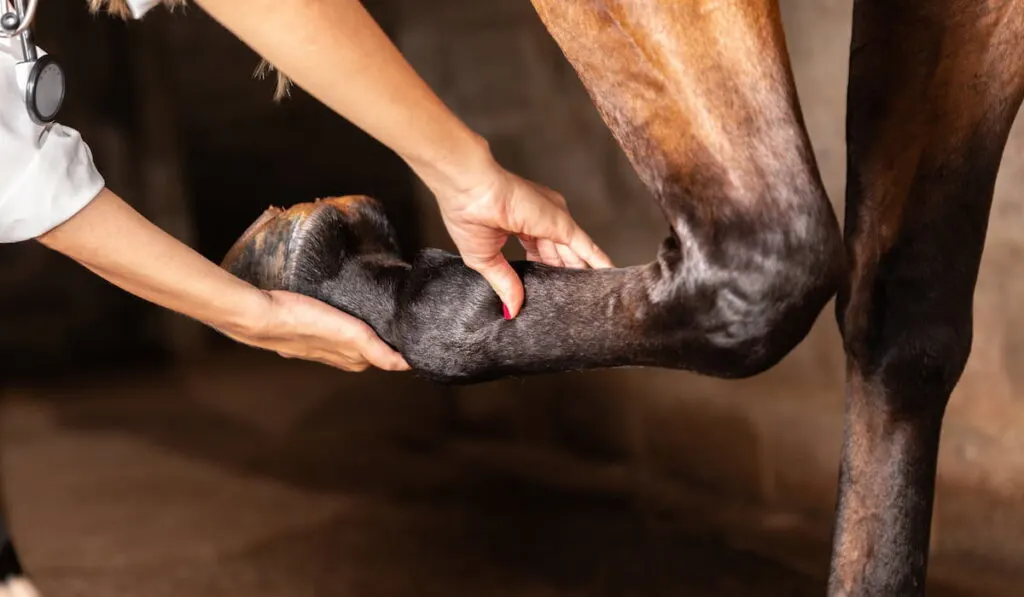
An injury to a tendon in a horse’s legs or its feet can include a tendon laceration, rupture, or severe inflammation. Horses can get lacerated or ruptured tendons through deep cuts, falling, running into sharp or hard objects, or being kicked by a fellow horse.
Tendon inflammation known as tenosynovitis occurs as a result of these and other injuries to the tendons. This causes fluid buildup that results in pain and leg lameness in horses. It can evolve into septic tenosynovitis, a much more painful and serious problem for horses. (source)
Bursitis
Bursitis can cause lameness in horses when a bursa, a sac containing fluid that protects joints, is damaged or inflamed and releases that fluid which causes reduced joint protection. This can cause severe pain in a horse.
Septic bursitis can form in these injuries causing an infection that must be treated as soon as possible. Bursitis can occur in any joint including those in the shoulder, elbows, knees or anywhere in a horse’s leg. (source)
Joint-Related Diseases
Joint-related diseases like arthritis and osteoarthritis cause inflammation in the joints. This causes pain that often results in lameness. With age, many horses will develop arthritis just like humans do.
Over time, the cartilage in a joint erodes away and results in joint fusion and a reduced ability to move comfortably. Just like with us, stiffness will occur, typically when a horse first starts to move or walk around. They may or may not improve as they day progress and depends on the severity of arthritis. (source)
Laminitis
Laminitis, often called ‘founder’ by equestrians, is a very painful and serious disease in horses often brought on by overfeeding either through grain or too-lush pastures. Sudden diet changes, being overweight, high fever along with other causes can lead to laminitis.
Laminitis can result in severe lameness issues. Signs of laminitis include repeated weight shifting when the horse is standing, heat radiating from the hooves, hesitant walk, and standing with their front legs stretched out to relieve the pain in the front of their hooves. (source)
Hoof Issues
Sometimes the issue causing the lameness in a horse can originate from the hoof itself. Dirt, debris and rocks can all get stuck in a horse’s hoof causing severe discomfort. Sometimes just simply removing the foreign object will cure the lameness your horse is exhibiting, but sometimes the issue is deeper and more complex.
Improper shoeing can result in bad hoof conformation which can lead to lameness. Thrush and canker are both pain-inducing infections that can occur in the hoof, originating from the frog, the center triangular area in a hoof that touches the ground when a horse is standing. Abscesses in the hoof are a common cause of lameness. (source)
Navicular Disease
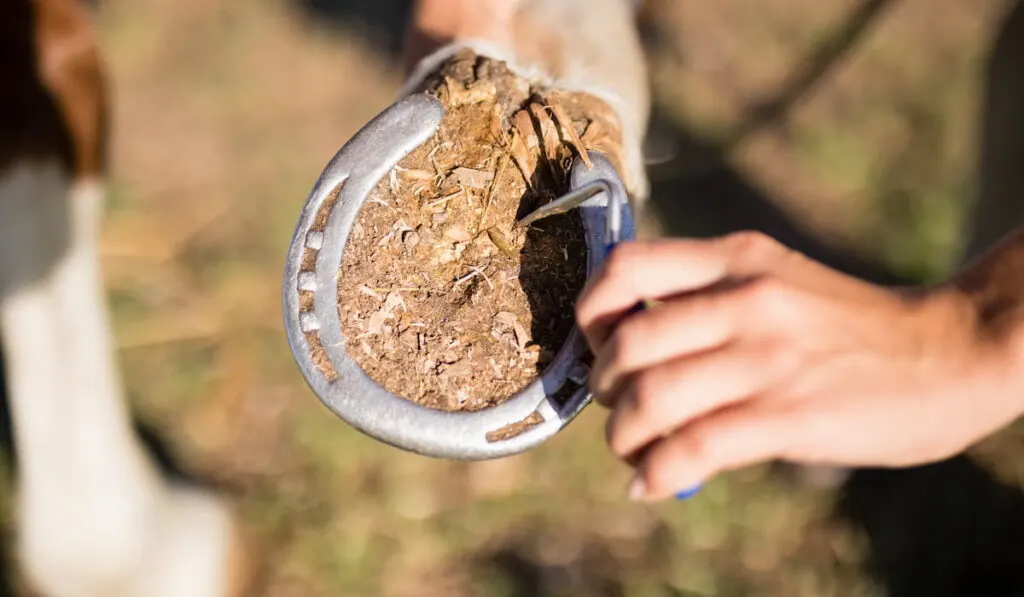
Although you might not have heard of it, navicular disease is a common cause of horse lameness in the front legs. Poor conformation, stopping too quickly, twisting the foot when running, or sudden changes in direction can all put stress on the navicular bone.
This disease can cause severe pain and can lead to long term damage. Prompt treatment by your vet and farrier is needed. (source)
Azoturia Syndrome
Often called ‘tying up’, this condition is caused by exertional myopathy. This occurs when there is a sudden and toxic release of lactic acid from the muscles.
This occurs most often in work horses that are on rest but still eating a diet high in carbohydrates. The lactic acid results in a myoglobin release that unfortunately can cause kidney failure.
Muscles will stiffen which makes it hard for the horse to walk or even stand. Symptoms include profuse sweating, rapid heart rate, stress and staggering. (source)
Determining a Diagnosis
A vet will perform a number of exams and tests to determine the exact cause of a horse’s lameness. Sometimes, the issue is easy to diagnose, but sometimes a more thorough exam is needed.
History
A thorough history is needed so that the vet can get a true idea about what could be causing the problem. Any history of lameness is important to discuss in case the same problem is reoccurring.
Be sure to note when the lameness began, any recent activity that could have contributed, and the progression of the lameness. This information, along with your horse’s breed and age will all be considered when trying to establish a possible diagnosis.
Exam
First a standing exam will be done to help assess the horse’s lameness and check for visible issues like injury, inflammation, or infection. All parts of the legs will be checked including the sole of the hoof.
Another exam will be done while the horse walks. Typically, getting a horse to trot will reveal more information on the severity and possible source of the problem. (source)
Flexion Tests
In a flexion test, a vet will manually bend certain joints or limb areas for a short time. After that, the horse trots away and the level of lameness is reviewed and compared to the level exhibited before the test.
Depending on how the levels compare and whether the level of lameness is better or more severe, the vet will be able to pinpoint the source of the pain. (source)
Hoof Testing
In a hoof test, a special tool is used to apply pressure to certain parts of the sole to reveal any painful areas. Some horses naturally have tender areas and this test may not be exact. The test works best if performed by an experienced tester. (source)
Nerve Blocks
Anesthetic nerve blocks are often given to horses exhibiting signs of lameness as a method of pain relief to help veterinarians find the source of the problem. Nerve blocks are sometimes given before imaging is done to prevent movement, but special care must be given to horses with severe lameness to prevent any additional injuries once the pain subsides.
Nerve blocks help veterinarians confirm the area of the injury. They are also given when certain surgical intervention is needed. (source)
Diagnostic Imaging
A variety of diagnostic imaging techniques can be used to determine the exact source of the pain or injury causing lameness in a horse. While some injuries are easy to spot, others hide deep within a horse’s body and diagnostic imaging may be the only way to confirm a diagnosis.
X-rays, ultrasounds, MRIs, CT scans, thermography and scintigraphy are all used depending on the severity of the lameness and the exams performed by the veterinarian. (source)
Treatment
The treatment for lameness depends on the official diagnosis for what is causing a horse’s lameness. Sometimes, for minor lameness and pain, rest and relaxation may be enough. For more severe problems, a more in-depth course of action is prescribed.
Injections and Medication
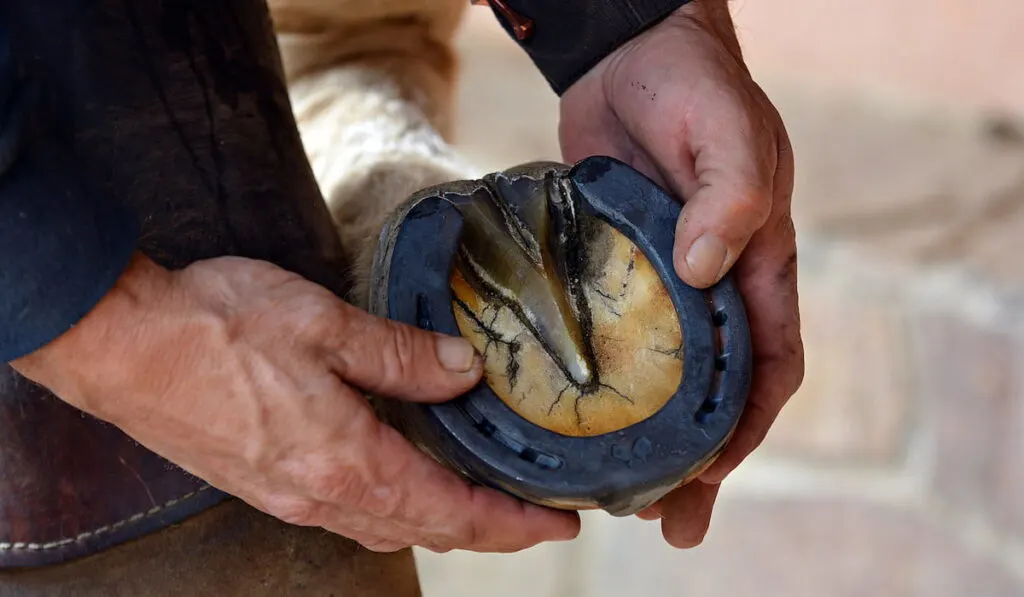
For inflammation or arthritis-related diagnoses, typically a steroid injection is usually the best treatment. Oral pain relievers and anti-inflammatory medication can also be given for horses suffering from inflammation or from chronic pain.
Antibiotics can help cure infections, anti-endotoxins will counter any toxicities within their body and vasodilators help improve blood pressure that in turn helps improve any blood flow issues in their hooves. There are many different medications available to treat different conditions. (source)
Surgical Intervention
Surgery is another option for severe cases of lameness caused by joint malfunctions and injuries. Arthroscopy is a common surgery performed to repairs injured joints that are causing a horse’s pain and subsequent lameness. A tiny camera helps the veterinarian use various instruments to complete the repair. (source)
Alternative Treatments
Science has progressed tremendously in the equine world and “regenerative therapies” such as stem cell injections and extra-corporeal shockwave treatments, along with others, can be administered to help relieve or cure the cause of the lameness.
Many equestrians swear by alternative therapies like equine chiropractic, acupuncture and massage therapies as exceptional non-invasive treatment options. (source)
Diet Alterations
For laminitis-related lameness, a vet will have to determine the main cause of the disease itself. Most often there will be dietary limits, fluid administration, hydration and medication if needed. (source)
Are Certain Horses More Likely to Have Lameness?
All horses, regardless of age, breed or primary sport or job, can become lame at some point in their lives.
According to the 2015 equine study performed by the NAHMS, quarter horses were by far the breed most likely to exhibit lameness, coming in at a whopping 40.3 percent. It is important to note that they were also the breed that made up the 38 percent of the horses in the study, the most by far.
Many people attribute this propensity for lameness to the quarter horse breed’s popularity in sporting events like barrel racing and team roping. The study also revealed that geldings were more likely than mares or stallions to have issues with lameness, as well as horses aged 11-15 years.
Recovery
Lameness recovery depends entirely on its cause. If the cause is something simple to fix, then a horse should recover in a short amount of time.
Lameness caused by wounds, hoof debris, and muscle strains all tend to have rather short recovery times. Laminitis, arthritis, severe hoof problems and leg fractures can take months to heal and repeated treatment may be necessary.
Any injury requiring surgery will need a long recovery time, but with the proper care and veterinary supervision, more than likely, your horse can recover fully from most bouts of lameness.
Some horses, unfortunately, may not be rideable after their lameness subsides, but they can go on to live long and healthy lives on your farm. If your horse is not recovering, or their lameness recurs or becomes more severe, you should consult with your veterinarian immediately.
Lameness Scale
The American Association of Equine Practitioners, AAEP, has developed a set of guidelines for grading the severity of lameness in a horse. It grades horses on an escalating scale of 0 through 5.
Grade 0: A grade of 0 indicates that a horse has no visible signs of lameness at all, regardless of whether it is standing, walking, turning, or running.
Grade 1: A grade of 1 on the lameness scale indicates that it is very difficult to visibly see the lameness and that it is not consistent in its appearance.
Grade 2: A level of 2 means that the horse’s lameness is difficult to see when it is walking or even trotting in a straight line, but it is easier to see at specific times, such as when they have a saddle on, walk on hard surfaces, or walk in circles.
Grade 3: A grade of 3 indicates that a horse’s lameness is observed constantly when the horse trots at any time, on any surface, with any amount of weight on their back.
Grade 4: At a 4 on the lameness scale, a horse’s lameness is very visible at even a slow walk.
Grade 5: A score of 5 on the lameness scale means that a horse can barely hold any weight on the affected area whether walking or just standing still, or they cannot move at all under any conditions. (source)
This video is a really neat way to kind of “quiz” yourself to see if you can identify which foot a horse is lame in based on its movement.
Final Thoughts
Horse lameness can be a very common symptom of a much bigger problem. While some causes of lameness can be easily fixed by an experienced equestrian, most causes of lameness will need to be diagnosed and treated by a veterinarian as soon as possible. If you follow the protocol they prescribed, there is a good chance your horse can recover fully from their lameness episode.

